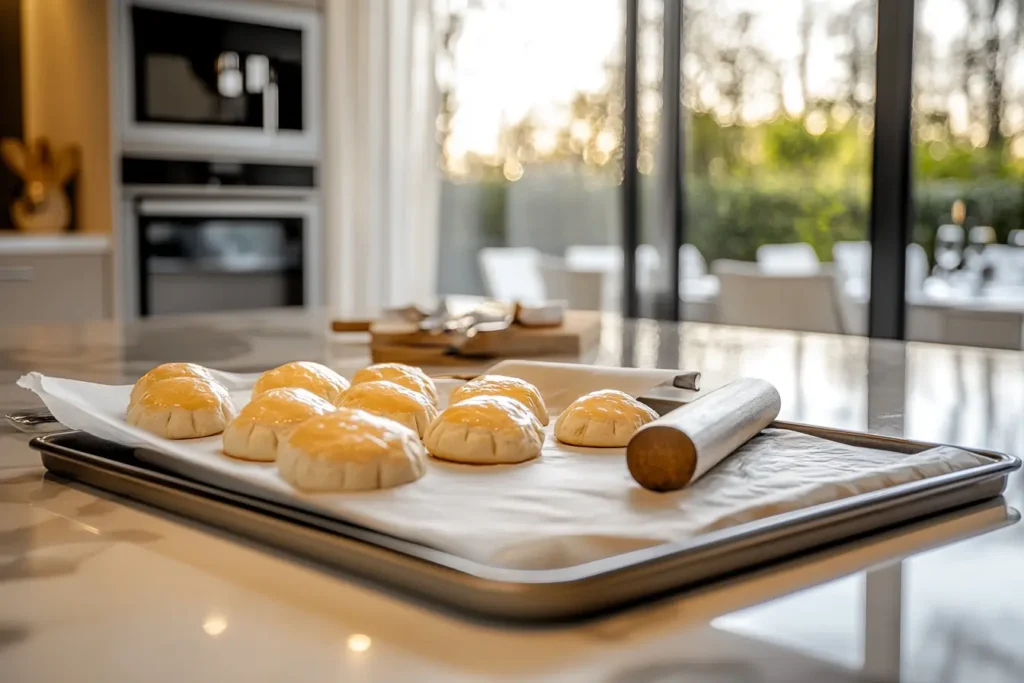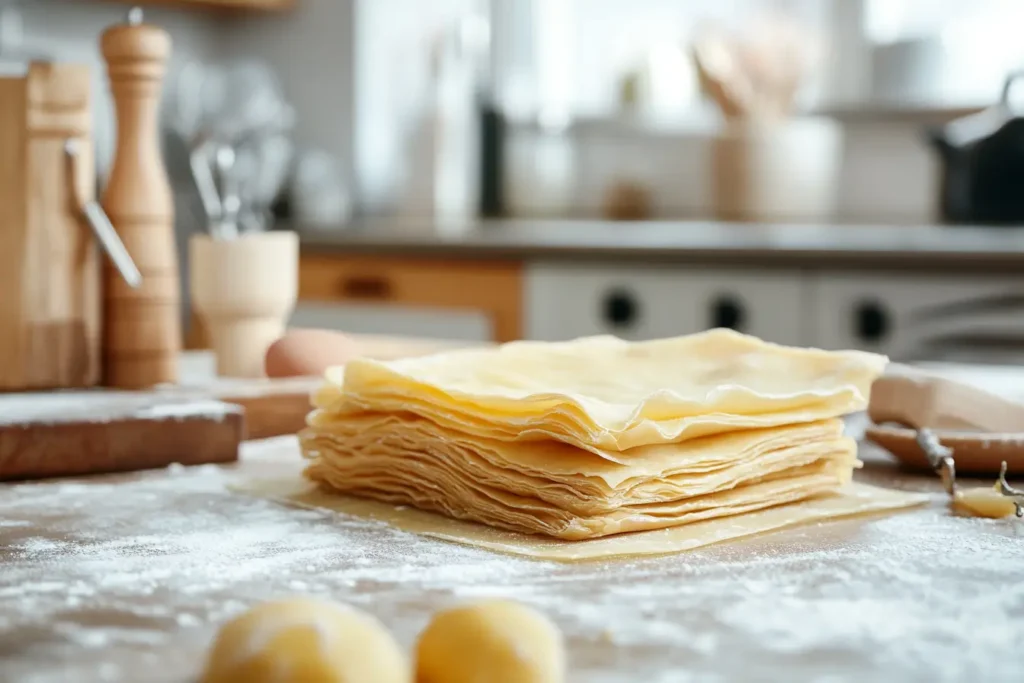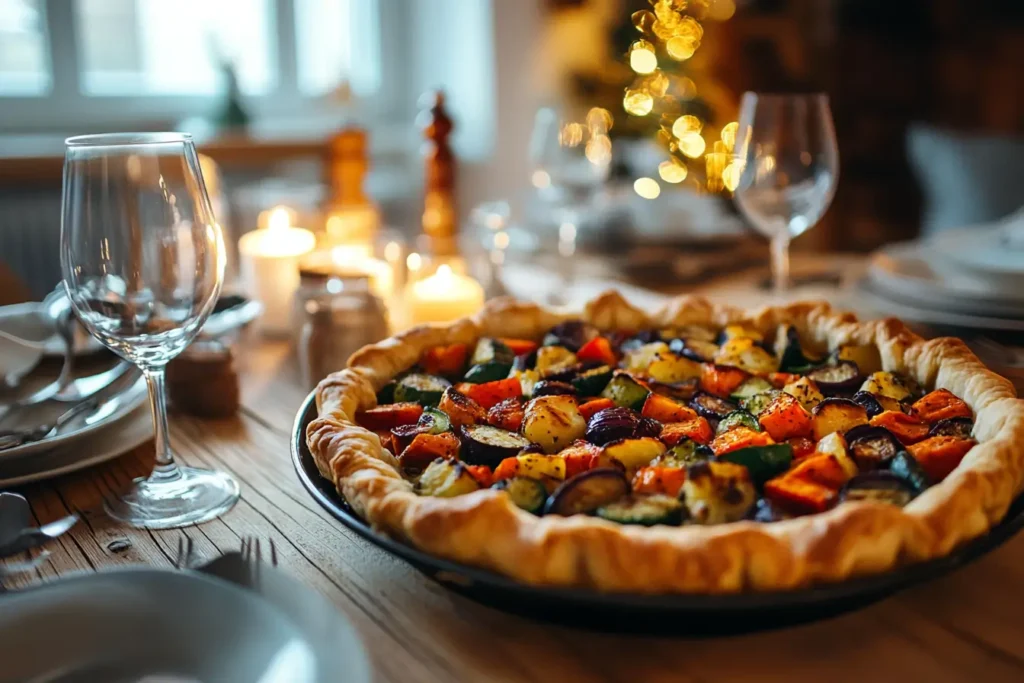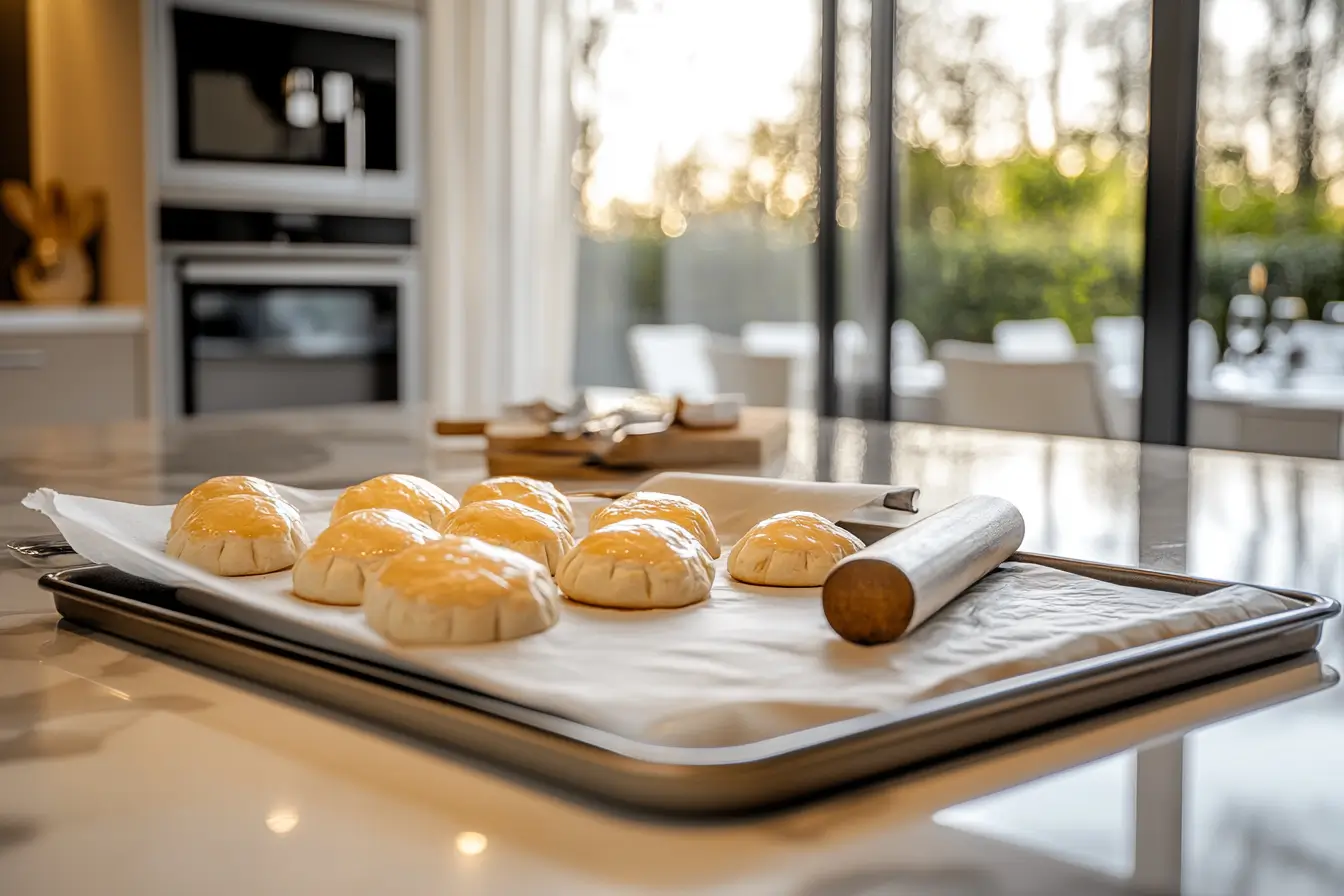
Pre-bake puff pastry is like the ultimate culinary magic trick—a little dough, a lot of butter, and voilà, it puffs into golden, flaky perfection. But here’s the million-dollar question: should you bake puff pastry before filling it? It’s a debate that divides bakers everywhere. Let’s dive deep into this question, uncover the secrets of puff pastry, and figure out when to pre-bake and when to skip it!
Understanding Puff Pastry: Basics and Composition
Before we answer the big question, let’s get to know puff pastry. What’s so special about it? Why does it puff? And how can you make it do exactly what you want?
What Is Puff Pastry Made Of?
At its heart, puff pastry is simply dough and butter. But don’t let its simplicity fool you—this is no ordinary dough. Puff pastry is made by folding butter into dough over and over, creating thin, buttery layers. When baked, those layers puff up like a balloon, thanks to the steam from the butter and water in the dough. It’s flaky, crispy, and downright irresistible.
How Does Puff Pastry Rise?
Here’s the science-y bit: puff pastry rises because of steam. When the pastry hits the oven, the butter melts, and the water in the dough evaporates. This steam pushes the layers apart, creating that iconic flaky texture.
Common Uses for Puff Pastry
From savory pies to sweet desserts, puff pastry is a kitchen superstar. Think chicken pot pies, cheese twists, fruit tarts, and even the good old sausage roll. It’s versatile and always a crowd-pleaser.
The Importance of Baking Puff Pastry Correctly
Now, let’s get down to business. Why does baking technique matter so much for puff pastry? The answer lies in its delicate structure.
Why Timing Matters in Baking Puff Pastry
Pre-bake puff pastry demands precision—there’s absolutely no room for mistakes. If you bake it too early, the bottom may stay soggy, which can ruin the texture entirely. On the other hand, baking it too late allows the filling to interfere with the delicate puffing process, leaving you with less-than-perfect results. Therefore, timing is everything; when you get it just right, your pastry will turn out crispy, golden, and absolutely delicious every single time.
Pre-Baking vs. Baking with Filling: What’s the Difference?
When you pre-bake puff pastry, also known as “blind baking,” you bake the pastry without the filling. This technique is perfect for recipes where you need the pastry fully cooked before adding a filling. On the flip side, baking with the filling lets the flavors meld together but requires careful planning to avoid sogginess.
Potential Risks of Skipping Pre-Baking
Skipping pre-baking can lead to disaster—think soggy bottoms or undercooked centers. Nobody wants that! Pre-baking helps create a strong, crispy base, especially for wet fillings like custards or fruit compotes.
When Should You Pre-Bake Puff Pastry?
So, when is pre-baking absolutely necessary? Let’s break it down.
Ideal Scenarios for Pre-Baking Puff Pastry
Pre-baking is your best friend when making:
- Quiches: Wet egg fillings need a sturdy, cooked base.
- Tarts with juicy fruits: Fruits release water as they bake, and pre-baking prevents the dreaded soggy bottom.
- Cream pies: You don’t want raw pastry under your silky filling.
Tips for Successfully Pre-Baking Puff Pastry
- Dock the dough: Use a fork to poke holes all over the pastry. This prevents it from puffing too much in the oven.
- Use weights: Baking weights or dried beans help keep the pastry flat and even.
- Bake until lightly golden: Don’t overdo it—just bake it enough to give it structure.
Pro Tip: “Always chill your puff pastry before baking—it helps the layers stay distinct and puffy! ❄️”
When to Skip Pre-Baking Puff Pastry
On the flip side, there are times when pre-baking isn’t necessary. Let’s explore when to take the simpler route.
Types of Fillings That Don’t Require Pre-Baking
If your filling isn’t overly wet or cooks at the same rate as the pastry, skip the pre-baking. For example:
- Savory pies with thickened sauces: These are usually fine to bake together.
- Turnovers: The pastry encases the filling completely, so no pre-baking is needed.
- Small appetizers or bites: These bake quickly, so the pastry and filling cook simultaneously.
Recipes That Work Best Without Pre-Baking
Some puff pastry recipes are designed to bake everything together, like:
- Classic apple turnovers
- Cheese and spinach puffs
- Sausage rolls
“Think of puff pastry like a dance partner—it needs to move in sync with the filling. Too much moisture throws off the rhythm!”
Common Problems When Baking Puff Pastry with Fillings
Even seasoned bakers face challenges with puff pastry. Let’s tackle the most common ones and their solutions.
Soggy Bottoms: Causes and Prevention
A soggy bottom is every baker’s nightmare. It happens when moisture from the filling seeps into the pastry. The fix? Pre-bake your pastry for wet fillings, or use a barrier like breadcrumbs or grated cheese to absorb excess liquid.
Uneven Cooking and Solutions
Sometimes, your puff pastry might cook unevenly—crispy on one side, raw on the other. To prevent this:
- Rotate your baking sheet halfway through.
- Use a preheated baking stone or steel for even heat distribution.
Overcooked or Burnt Puff Pastry: How to Avoid It
Burnt puff pastry is a sad sight, but luckily, it’s completely avoidable with a few mindful steps. To start, keeping an eye on your oven temperature is crucial. Ideally, puff pastry should be baked at 375°F to 400°F, which is the sweet spot for achieving that perfect golden hue. However, if the temperature is too high, those delicate layers can quickly go from perfectly crisp to overdone.
To prevent mishaps, always set a timer. It’s surprisingly easy to lose track of time while multitasking in the kitchen, and puff pastry waits for no one. For example, stepping away for just a few extra minutes can mean the difference between deliciously golden layers and a burnt disappointment. Furthermore, if you notice uneven browning, rotating your baking tray halfway through cooking can help distribute heat more evenly.
Another tip is to monitor your pastry closely as it approaches the end of its baking time. Although recipes may provide a general guideline, every oven is slightly different. Check the pastry a few minutes before the suggested bake time is up to ensure you don’t miss that perfect golden-brown stage. Additionally, using a baking thermometer to verify your oven’s temperature can be a game-changer if you suspect your oven runs hotter than it should.
Finally, when experimenting with recipes, remember that fillings and toppings can also impact baking times. For instance, if you’re making a pie or tart, the extra moisture from the filling might require adjusting the time slightly to avoid overcooking the edges.
By taking these small but effective precautions, you can ensure your puff pastry always turns out beautifully golden and flaky instead of disappointingly burnt. After all, why settle for anything less than perfection?
Finding the Balance Between Pre-Baking and Filling
So, should you bake puff pastry before filling it? The answer is: it depends! It all comes down to the type of recipe, the filling, and the result you want. Master the art of pre-baking when needed, and know when to skip it for a seamless baking experience.
Step-by-Step Guide to Pre-Baking Puff Pastry

Pre-baking puff pastry, also known as “blind baking,” is essential for recipes with wet fillings or when you need a crispy base. Here’s how to do it right.
Step 1: Preparing the Dough for Pre-Baking
Start with quality puff pastry. You can use store-bought or homemade, but make sure it’s cold and firm—this helps maintain those signature layers.
- Thaw the pastry: If you’re using frozen puff pastry, let it thaw in the fridge for about 30 minutes until it’s pliable but still cool.
- Roll it out: On a lightly floured surface, roll out the pastry to your desired size and thickness. Don’t overwork it; you don’t want to lose the layers.
Pro Tip: “Use a light touch when rolling puff pastry—think of it as whispering to the dough, not shouting at it!”
Step 2: Techniques for Docking Puff Pastry
Docking is crucial for preventing the pastry from puffing too much during baking. Here’s how:
- Use a fork to poke holes all over the dough.
- Be generous with the docking but avoid piercing through completely.
- For a more polished look, leave the edges undocked for a decorative puff.
Step 3: Using Baking Weights or Beans Effectively
To keep your pastry flat, you’ll need some weight:
- Line the pastry: Place parchment paper or aluminum foil over the pastry.
- Add weights: Fill the lined pastry with baking weights, dried beans, or even rice. This ensures the pastry stays flat and cooks evenly.
Step 4: Baking Until Lightly Golden
- Preheat your oven to 375°F to 400°F (190°C to 200°C).
- Place the pastry in the oven and bake for 10-12 minutes with the weights in place.
- Remove the weights and parchment, then bake for another 5-7 minutes until the pastry is lightly golden.
“Think of this as a two-step process—first, you’re setting the structure; then, you’re adding the finishing touch. Easy, right? 😊”
How to Fill Puff Pastry After Pre-Baking

Once your pastry is pre-baked, it’s time to add the filling. This step is where creativity and technique come together.
Best Practices for Adding Fillings to Pre-Baked Pastry
- Cool the base: Let your pre-baked pastry cool completely before adding the filling. Hot pastry can make fillings runny.
- Spread evenly: Use a spatula to spread your filling evenly, ensuring no weak spots.
- Avoid overfilling: Less is more when it comes to puff pastry. Overfilling can weigh it down and affect the rise.
Choosing the Right Fillings for Pre-Baked Pastry
The filling is the star of the show! Here are some great options:
- Savory fillings: Spinach and feta, roasted vegetables, or creamy chicken.
- Sweet fillings: Vanilla custard, lemon curd, or fresh berries.
Quote: “Puff pastry is like a blank canvas, and your filling is the masterpiece. Choose wisely, and your creation will shine!”
Recipes and Techniques for Puff Pastry Success
Let’s put your newfound knowledge to the test with some classic recipes.
Savory Recipes That Require Pre-Baking
Spinach and Feta Tart
- Pre-bake puff pastry as outlined above.
- Mix cooked spinach, crumbled feta, and a touch of nutmeg.
- Spread the filling over the cooled pastry and bake at 350°F for 15-20 minutes.
Tomato and Goat Cheese Galette
- Layer slices of heirloom tomatoes and goat cheese on the pre-baked crust.
- Drizzle with olive oil and sprinkle with fresh thyme.
- Bake at 375°F until the edges are golden.
Sweet Recipes That Work with Pre-Baking
Custard Fruit Tart
- Fill the pre-baked crust with a layer of vanilla custard.
- Top with fresh fruits like kiwi, strawberries, and blueberries.
- Glaze with apricot jam for a glossy finish.
Chocolate Ganache Tart
- Pour warm ganache (a mix of melted chocolate and cream) into the pre-baked shell.
- Chill until set, then top with a sprinkle of sea salt for contrast.
Expert Tips for Perfect Puff Pastry Every Time
Ready to level up your puff pastry game? Here are some insider secrets:
The Role of Temperature and Timing
- Always bake puff pastry in a hot oven (375°F to 400°F). The initial heat blast is what makes the layers puff up.
- Avoid opening the oven door too often—it disrupts the temperature and can affect the rise.
Using Baking Weights or Beans Effectively
Weights are your pre-baking besties, but here’s a trick: freeze the lined pastry with weights for 10 minutes before baking. It helps lock in the layers.
“Patience and precision are the secret ingredients for perfect puff pastry. Trust the process, and you’ll be rewarded!”
Frequently Asked Questions About Puff Pastry
Can You Bake Puff Pastry Twice?
Yes, you can bake puff pastry twice! This technique is often used when you need to pre-bake the crust for a quiche or tart before adding a filling. The key is to ensure you don’t overbake during the first round so the pastry doesn’t lose its flaky texture. For creative puff pastry ideas, check out types of puff pastry to explore the options available for different recipes.
What Happens if You Skip Pre-Baking?
Skipping pre-baking can lead to a soggy, undercooked base—something no one wants. Pre-baking helps prevent this by creating a firm foundation for your filling. For inspiration on desserts that use pre-baking techniques, you might like puff pastry dessert recipes.
How Long Can Pre-Baked Puff Pastry Be Stored?
You can store pre-baked puff pastry in an airtight container for up to two days at room temperature or freeze it for up to a month. If you’re planning to make dessert tarts or pies, read common desserts to see how puff pastry fits into traditional sweets.
Conclusion: The Perfect Puff Pastry Awaits
Baking puff pastry is an art that requires both precision and creativity. Whether you choose to pre-bake puff pastry for wet fillings or bake it alongside the filling for perfectly blended flavors, success lies in understanding the unique needs of your recipe. By mastering these techniques and tips, you can ensure your puff pastry creations will always turn out irresistibly flaky, golden, and delicious.
For more insights and ideas on working with puff pastry, don’t forget to explore related topics like types of puff pastry and puff pastry dessert recipes. Happy baking! 🥐✨

